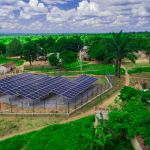Igniting Growth in the DRC: How Renewable Energy Can Power Urban Development
Situated on the northern shore of Lake Kivu, Goma is a city mired in conflict and instability. The UN has maintained a fragile peace in North Kivu since the Congolese army regained nominal control in 2013, but rebel attacks and the recent Ebola outbreak continue to disrupt development.
As local residents look to the future following the election in late 2018, fears of economic instability and unemployment are becoming greater than the fears of rebel attacks. For the region to recover and move away from conflict, people need jobs, local enterprise and the restoration of economic activity. Businesses require access to basic infrastructures in order to succeed and energy is perhaps the most important of all.
In 2018, I led a project with the University of Edinburgh to conduct research in North Kivu to explore the impact of energy provision on the local economy. The research surveyed local businesses, investigating their energy use and its impact on their activities. It also looked at how local power suppliers were meeting the increasing energy demand in the region.
Unreliable Energy = Unpredictable Lives
In Goma and across the Democratic Republic of Congo, just 9 percent of the population have access to electricity. The grid is run by Société Nationale d’Électricité (SNEL), an government controlled utility that relies on inefficient colonial-era hydroelectric plants for power. It’s notable that more power is dedicated to the beer and bottling factory of Bralima (7MW), owned by Heineken, than for the entire city of Goma (6.5MW) with one million people.
SNEL works for an unpredictable 6.7 hours per day, meaning customers cannot plan their activities according to scheduled outages. Sixty-three percent also reported problems with the quality of power. However, the biggest problem is trust; 67 percent of businesses surveyed said they didn’t trust their SNEL bill. Forty-two percent negotiated their bills, and 23 percent made additional payments to SNEL or its employees outside the bill. Electricity meters are old, broken, non-existent, or simply ignored. Businesses rightly do not believe that their bills are an accurate measure of the energy they have received. SNEL quotes their price/kWh at 0.13$/kWh, but our research discovered that most bills rely on estimates and were inflating costs to the consumers. The true cost of SNEL energy averages 0.41$/kWh.
Eighty-six percent of businesses surveyed agreed or strongly agreed that a lack of reliable electricity prevents their business from operating properly. SNEL’s unreliable and inconsistent service forces consumers to rely on back-up solar panels or generator power. Though 73 percent have a grid connection, companies use an average of 2.2 power sources to meet their energy needs.
Across all power sources, including diesel generators, the average cost of energy is 0.73$/kWh, considerably more than the 0.12$/kWh for grid electricity in neighbouring Rwanda. For customers, the smaller the daily consumption, the higher the price of the electricity per kWh they are paying.
In cities towards the interior, with no paved road connections, and no grid whatsoever, the reliance on diesel generators is even greater. Diesel can cost up to $3/litre (versus $1.10 in Goma), a considerable and often untenable expense for a business struggling to break even. The DRC needs an alternative to this expensive and inadequate situation.
Going Off-Grid in the City
Off-grid solar systems, which provide an affordable panel and solar-powered products, have been a key part of reaching the rural poor across East Africa. Thus far, off-grid solar providers have shied away from the DRC, but this research shows the country presents a compelling market.
There is vast potential to serve urban consumers and businesses whose needs are not currently met by the grid. They have higher levels of demand and ability to pay, making large solar home systems or mini-grids a financially viable option. Innovative renewable energy suppliers are well placed to pilot new concepts at a competitive price and achieve sustainable returns.
Electrifying a city in the twenty-first century requires a diverse approach using multiple energy sources fit for consumer purposes. Lessons from this research in the Kivu Regions could serve as a model for a diverse energy system reaching across the DRC, that could include:
- Grid connection for large industry;
- Mini-grids powered by solar and hydro for medium-size “anchor” businesses and neighbouring households;
- Large solar home systems for small businesses and large households;
- “Pico-solar” for low-income households.
The DRC already employs a myriad of energy solutions in a patchwork across cities. So the behavioural change required to shift to this model would be far less drastic than in locations with a functioning grid. Thus the DRC could demonstrate “leapfrogging” at scale, and provide an example for other post-conflict countries to emulate.
Such a system would have additional security advantages. Energy infrastructure is an obvious target in a conflict, and attacks can result in massive disruption. In the 1998 Congolese war, rebels targeted and captured the Inga hydroelectric dam, cutting off electricity and water to 6 million people in Kinshasa. Decentralised energy systems present less of a target for rebels, and lessen their ability to impact the wellbeing of a city.
Stable Electricity in a Fragile Context
There are many policy barriers to overcome, requiring political will that is currently lacking in the complex landscape of the DRC. The complex institutional functions and poor systems of governance and regulation pose a considerable deterrent to investment. Yet flexible long-term capital from the private sector that can adapt to the challenges of the Congolese marketplace will be essential to achieve this vision. More research is needed to set appropriate tariff rates, accurately measure urban business demand, pilot and measure different revenue generation models and assess the risks and benefits of these interventions in the market.
This research shows that electricity provision is failing mid-range consumers in the Kivu Regions. New approaches from renewable energy providers such as solar home systems (BBOXX) and hydro mini-grids (Virunga) are already underway. Such investments are demonstrating that new models and energy technologies are feasible in a fragile urban context, and can help to catalyse economic development. For the Kivu Regions, this is a critical part of de-escalating the conflict and facilitating a path to long-lasting peace.
Flavia Howard is a senior consultant in the Nairobi office of Dalberg Advisors.
Image courtesy of Axel Fassio/CIFOR.
- Categories
- Energy



